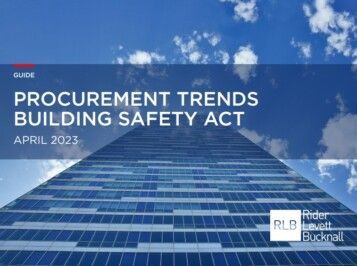We all know that the Building Safety Act will have a significant impact on the delivery of higher risk buildings and the requirements of the Act need to be understood by those procuring such buildings.
It was in this context that we undertook our Procurement Trends survey that took a look at contractors’ capacity and preparedness for the Act. As the industry takes stock of the soon to be released secondary legislation, which we will follow up with further advice, we have summarised what those respondents told us and what the consequences of the Act might mean to their business.
Key findings
- Our Procurement Trends Survey reassuringly shows a good degree of readiness for the Act throughout the supply chain with 71% of contractors reporting that they are fully prepared for the Act. Yet, clients and their advisors will need to undertake rigorous testing of this finding by undertaking their own assessments of contractor competency, both at pre-qualification stage and in the resources proposed for a project at tender stage.
- Some contractors report they will no longer be undertaking work on higher risk buildings and over 50% state that they have adopted their bid/no-bid strategies. Consequently, the thought that project teams give to the Building Safety Act and its obligations is undoubtedly going to impact the market appeal of a project taken to the market. Clearly defined responsibilities, design status and timescales for passing through each of the gateways are likely to be key things getting attention in Tender Documents.
Just over 50% of contractors expect there to be an increase in costs. Any cost planning of projects should be cognisant of the likely procurement route, and this may well impact preliminaries. We expect Tier One contractors to need to adjust their resourcing of projects less than Tier Two or Three contractors might.
- There was concern on the impact that the three gateways will have on the industry. This is understandable as at the time of survey the secondary legislation was yet to be released. It will be interesting to see if the secondary legislation abates those fears.
Embracing the change
It can only be right that the industry has apprehensions about the Building Safety Act. It is rightly intended to change industry practice and place compliance and safety front and centre of the delivery of our buildings, and I believe the industry should, and will, positively embrace the change in its working practices and regulatory regime. The Building Safety Act will require leadership in its implementation, it will require communication amongst project teams and most importantly it will require cultural change – all which as an industry we need to ensure happens.
Those procuring buildings are at a critical interface of a project as it transitions from being on the drawing to becoming a physical asset. They have a key role to play in understanding the Act and playing their part in the communication of that change and its manifestation in contract documents. More importantly we owe it to the industry to play our part in the cultural change that goes beyond the contract.
The RLB team is pleased to be releasing guidance on the impact the Act may have at the procurement stage of a project. To register for this guidance, please contact Paul Sambrook.
FURTHER INFORMATION:




